Anna Boleyn/Anne Boleyn (1920) is one of the silent historical films directed in Germany by the young Ernst Lubitsch. Henny Porten starred as the ill-fated Anne Boleyn and Emil Jannings as King Henry VIII. Ross Verlag published a wonderful series of sepia postcards of the film, often with photos by the Rembrandt studio in Berlin.
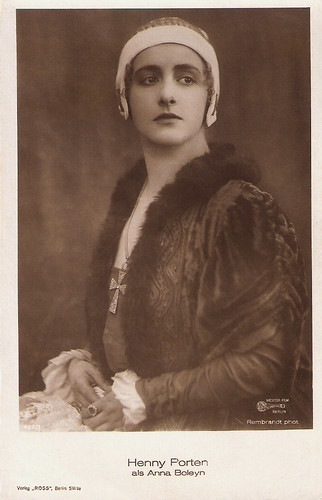
German postcard by Ross Verlag, Berlin, no. 402/1, 1919-1924. Photo: Rembrandt Phot. / Messter Film, Berlin. Publicity still for Anna Boleyn (Ernst Lubitsch, 1920).
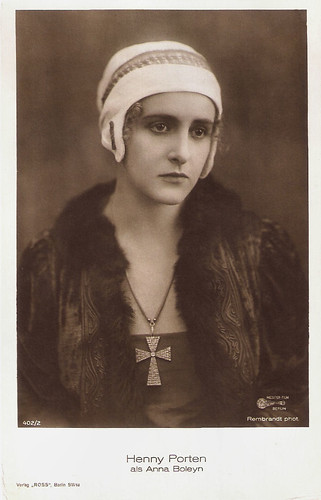
German postcard by Ross Verlag, Berlin, no. 402/2, 1919-1924. Photo: Rembrandt Phot. / Messter Film, Berlin. Publicity still for Anna Boleyn (Ernst Lubitsch, 1920).
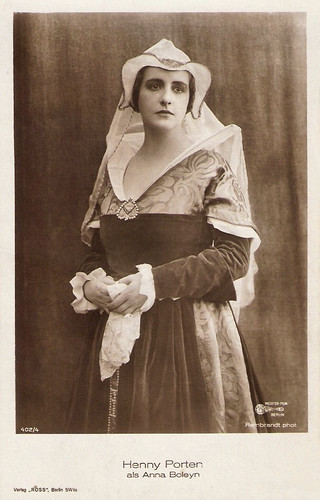
German postcard by Ross Verlag, Berlin, no. 402/4, 1919-1924. Photo: Rembrandt Phot. / Messter Film, Berlin. Publicity still for Anna Boleyn (Ernst Lubitsch, 1920) with Henny Porten.
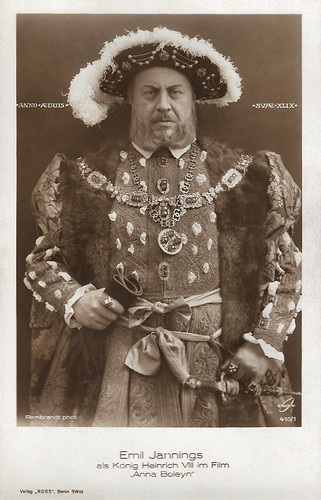
German postcard by Ross Verlag, no. 410/1. Photo: Rembraandt / Union-Film. Emil Jannings as Henry VIII in Anna Boleyn (Ernst Lubitsch, 1920).
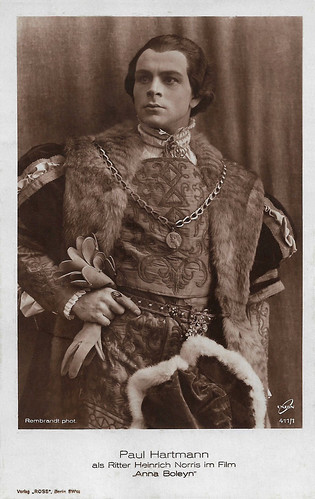
German postcard by Ross Verlag, no. 411/1. Photo: Rembrandt / Union. Paul Hartmann as Sir Henry Norris in Anna Boleyn (Ernst Lubitsch, 1920).
Anne Boleyn was the second wife of King Henry VIII of England. Their marriage led to momentous political and religious turmoil. For Ernst Lubitsch' film the script was written by Norbert Falk (as Fred Orbing) and Hanns Kräly.
Lubitsch presents Anna (Henny Porten) as an innocent, a naïve and guileless young woman who is the newly arrived lady-in-waiting to the Queen. She catches the lustful eye of Henry VIII (Emil Jannings), who loves to feast, drink, hunt, and chase around after young beauties. He is tired of Queen to Catherine of Aragon (Hedwig Pauly-Winterstein), and annuls his marriage to her, against the wishes of the pope.
The pompous monarch breaks with Rome, forms the Church of England and marries Anne at the Cathedral. The marriage and the sumptuous festivities that follow are filmed by Lubitsch as spectacular crowd scenes.
Henry tells Anne it is her holy duty to produce a male heir to the throne. But when Anne only gives birth to a baby girl (the later Queen Elizabeth), Henry VIII soon has his eye on yet another lady-in-waiting, Jane Seymour (Aud Egede Nissen).
The bad-tempered King charges his wife with adultery and treason, and imprisons her in the Tower of London. Anne is tortured and confesses to infidelity. She is sentenced to death and in the final scene of the film she is beheaded.
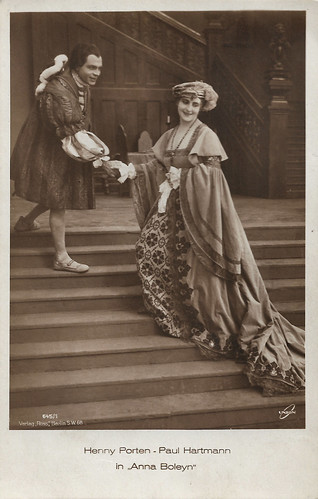
German postcard by Ross Verlag, Berlin, no. 645/1. Photo: Union. Publicity still for Anna Boleyn (Ernst Lubitsch, 1920) with Henny Porten and Paul Hartmann.
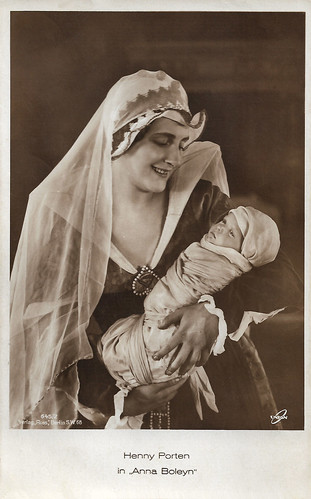
German postcard by Ross Verlag, Berlin, no. 645/2. Photo: Union. Publicity still for Anna Boleyn (Ernst Lubitsch, 1920) with Henny Porten.
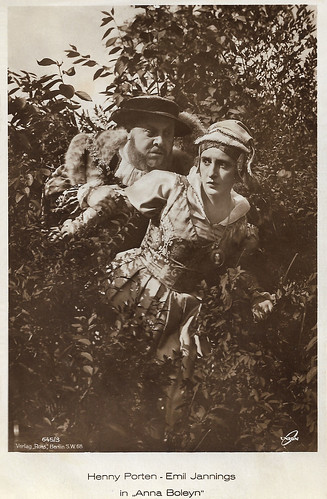
German postcard by Ross Verlag, Berlin, no. 645/3. Photo: Union Film. Publicity still for Anna Boleyn (Ernst Lubitsch, 1920) with Emil Jannings and Henny Porten.
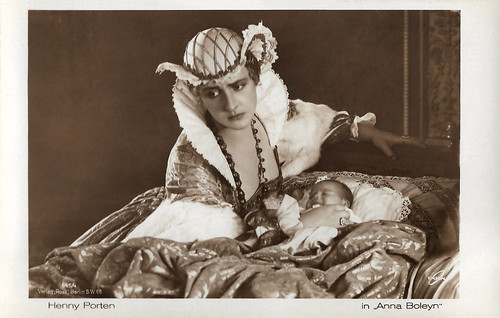
German postcard by Ross Verlag, Berlin, no. 645/4. Photo: Union Film. The baby represents the future queen Elizabeth I.
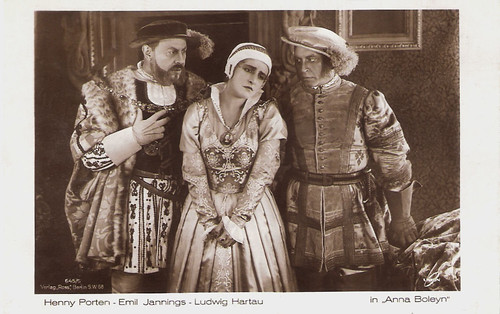
German postcard by Ross Verlag, Berlin, no. 645/5. Photo: Union. Publicity still for Anna Boleyn (Ernst Lubitsch, 1920) with Emil Jannings, Henny Porten and Ludwig Hartau as the Duke of Norfolk.
In Anna Boleyn/Anne Boleyn (1920), Ernst Lubitsch lets his characters breathe and reveal their corruption down to the tiniest of meannesses. He takes his time, which can try the patience of an audience accustomed to being carried away by action, but the time is worth spending.
A beautiful aspect of Anna Boleyn are the very lavish medieval costuming and the large and elaborate exterior and interior sets. The outdoor scenes are impressive for 1920: a court sports event, Anna’s coronation, a Spring Festival, a hunt, a joust, and even a street battle outside the cathedral.
Emil Jannings is striking and memorable as King Henry the Eighth. He seems to have stepped straight out of Hans Holbein's famous portrait of King Henry VIII.
To introduce the king, Lubitsch uses one of his favourite comedy techniques: the pull-back-and-reveal. A year earlier, he had used this technique in the opening shot of Die Austernprinzessin/The Oyster Princess (1919) to show the bloated Oyster King surrounded by his lackeys. That shot is duplicated here and the look is slightly more realistic but just as revelatory of the character.
Anna Boleyn’s innocence is underlined by Lubitsch through the contrast with the very different character of Jane Seymour (Aud Egede Nissen). Jane is in a sense a mirror image in negative of Anna (Henny Porten). In the late confrontation between the two, Jane claims that she serves Anna, but Lubitsch once again positions Anna as innocent: here, dressed in a simple nightdress, Anna kneels before the haughty Jane in her fine clothes.
Ernst Lubitsch constantly composes shots in depth in Anna Boleyn, looking down corridors or through into larger rooms, from the early moments at the harbour where a set of doors are opened onto a bustling street, to the haunting final view of the scaffold.
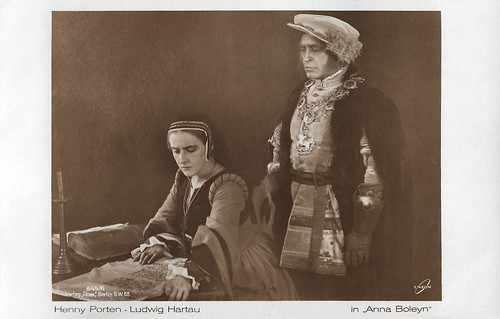
German postcard by Ross Verlag, Berlin, no. 645/6. Photo: Union. Publicity still for Anna Boleyn (Ernst Lubitsch, 1920) with Henny Porten and Ludwig Hartau.
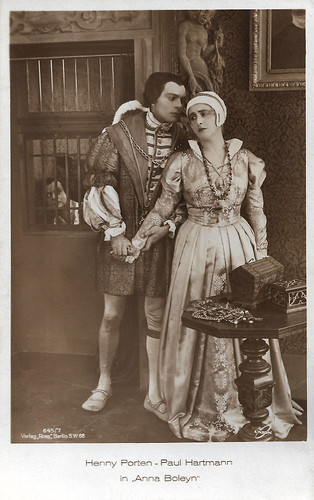
German postcard by Ross Verlag, Berlin, no. 645/7. Photo: Union. Publicity still for Anna Boleyn (Ernst Lubitsch, 1920) with Henny Porten (Anna Boleyn) and Paul Hartmann (Sir Henry Norris). Anna is loyal to her King, so she rejects Henry's love. The diabolic court poet Marc Smeton (Ferdinand von Alten) spies upon them and will betray them to the King.
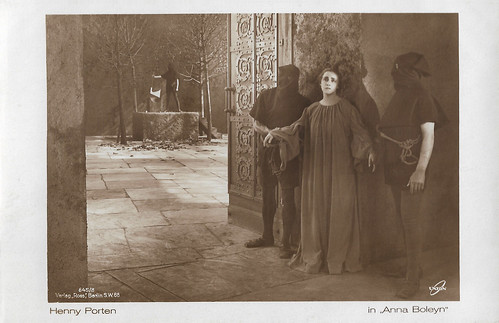
German postcard by Ross Verlag, no. 645/8. Photo: Union. Publicity still for Anna Boleyn (Ernst Lubitsch, 1920) with Henny Porten.

German postcard by Ross Verlag, Berlin, no. 472/1. Photo: Rembrandt Phot. / Union Film with Aud Egede Nissen

For the film Anna Boleyn a tournament set is built at the Tempelhof studio. German collectors card by Ross Verlag in the series Vom Werden Deutscher Filmkunst - Der Stumme Film, no. 149, group 43. Photo: Union-Messter-Film.

And as it later appeared in the film. German collectors card by Ross Verlag in the series Vom Werden Deutscher Filmkunst - Der Stumme Film, picture no. 150, group 43. Photo: Ufa. Set for Anna Boleyn (Ernst Lubitsch, 1920).
Most critics on the net have mixed thoughts about the film. Ian Johnston at Not Coming to a Theater Near You: "Anna Boleyn does everything to meet the requirements of the historical epic. (...) But the film suffers from Anna’s bland characterisation and a general plodding, predictable tone. It only really comes alive with the character of King Henry."
Lubitsch' film was not the only art work inspired by the tragic figure of Anna Boleyn. Anna has inspired or been mentioned in numerous paintings, novels and films.
In the cinema, she was first portrayed by Clara Kimball Young in a 1912 short film about Cardinal Wolsey. After the portrayal by Henny Porten followed Merle Oberon in the sound film The Private Life of Henry VIII which won an Oscar for Charles Laughton's portrayal of Henry. Oberon received an Oscar nomination.
Elaine Stewart played Anne Boleyn in the film Young Bess (1953), starring Jean Simmons. Geneviève Bujold won a Golden Globe Award, and was nominated for an Oscar, for her portrayal of Anne in Anne of the Thousand Days (1969).
Dorothy Tutin was nominated for a BAFTA TV Award for her role as Anne in the mini-series The Six Wives of Henry VIII (1970). When that mini-series was compressed into a film, Charlotte Rampling played Anne in the film version entitled Henry VIII and his Six Wives (1972). And, Natalie Portman portrayed Anne excellently in the film The Other Boleyn Girl (2008).
Finally, reviewer Helotropetwo at IMDb, loves Lubitsch's Anna Boleyn: "Nothing dull about this movie, which is held together by fully realized characters with some depth to them. Even the hooded torturers have body language. Jannings' performance is brilliant, all will, want and need. A Henry VIII as he must have been. Henny Porten is, maybe, nobler and purer than Anne Boleyn, but she plays the part as written: A victim caught in the jaws of a big (huge) baby."
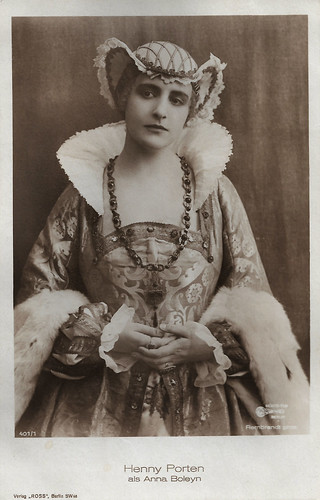
German postcard by Ross Verlag, Berlin, no. 401/1. Photo: Rembrandt / Messter Film. Henny Porten in Anna Boleyn (Ernst Lubitsch, 1920).
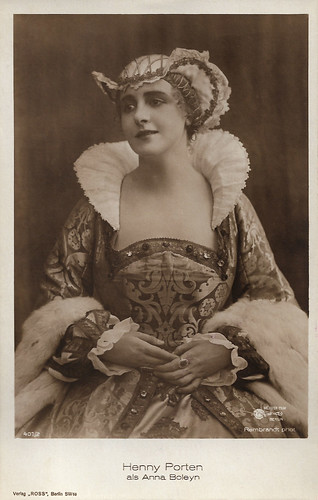
German postcard by Ross Verlag, Berlin, no. 401/2. Photo: Rembrandt Phot. / Messter Film, Berlin. Publicity still for Anna Boleyn (Ernst Lubitsch, 1920).
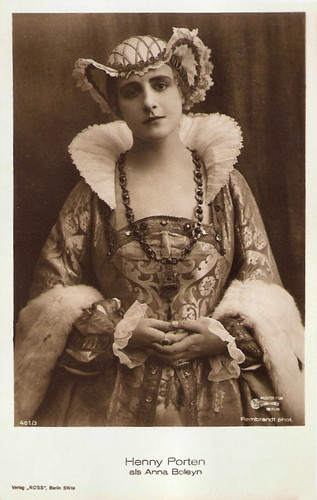
German postcard by Ross Verlag, Berlin, no. 401/3. Photo: Rembrandt Phot. / Messter Film, Berlin. Publicity still for Anna Boleyn (Ernst Lubitsch, 1920).
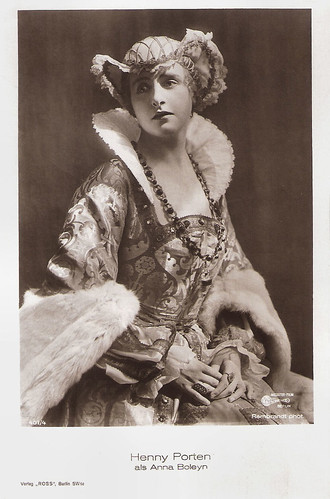
German postcard by Ross Verlag, Berlin, no. 401/4. Photo: Rembrandt Phot. / Messter Film, Berlin. Publicity still for Anna Boleyn (Ernst Lubitsch, 1920).

German postcard by Ross Verlag, Berlin, no. 401/5. Photo: Rembrandt Phot. / Messter Film, Berlin. Publicity still for Anna Boleyn (Ernst Lubitsch, 1920).
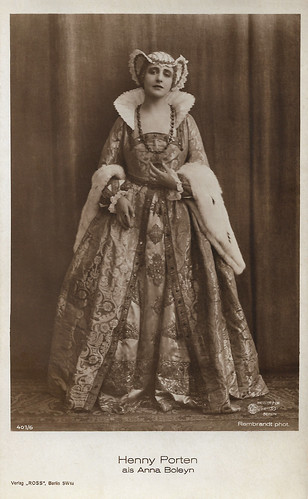
German postcard by Ross Verlag, Berlin, no. 401/6. Photo: Rembrandt Phot. / Messter Film, Berlin. Henny Porten in Anna Boleyn (Ernst Lubitsch, 1920).
Sources: Jason Ankeny (AllMovie), Fernando F. Croce (Slant), Ian Johnston (Not Coming to a Theater Near You), AllMovie, Wikipedia and IMDb.

German postcard by Ross Verlag, Berlin, no. 402/1, 1919-1924. Photo: Rembrandt Phot. / Messter Film, Berlin. Publicity still for Anna Boleyn (Ernst Lubitsch, 1920).

German postcard by Ross Verlag, Berlin, no. 402/2, 1919-1924. Photo: Rembrandt Phot. / Messter Film, Berlin. Publicity still for Anna Boleyn (Ernst Lubitsch, 1920).

German postcard by Ross Verlag, Berlin, no. 402/4, 1919-1924. Photo: Rembrandt Phot. / Messter Film, Berlin. Publicity still for Anna Boleyn (Ernst Lubitsch, 1920) with Henny Porten.

German postcard by Ross Verlag, no. 410/1. Photo: Rembraandt / Union-Film. Emil Jannings as Henry VIII in Anna Boleyn (Ernst Lubitsch, 1920).

German postcard by Ross Verlag, no. 411/1. Photo: Rembrandt / Union. Paul Hartmann as Sir Henry Norris in Anna Boleyn (Ernst Lubitsch, 1920).
The Bad Tempered King of England
Anne Boleyn was the second wife of King Henry VIII of England. Their marriage led to momentous political and religious turmoil. For Ernst Lubitsch' film the script was written by Norbert Falk (as Fred Orbing) and Hanns Kräly.
Lubitsch presents Anna (Henny Porten) as an innocent, a naïve and guileless young woman who is the newly arrived lady-in-waiting to the Queen. She catches the lustful eye of Henry VIII (Emil Jannings), who loves to feast, drink, hunt, and chase around after young beauties. He is tired of Queen to Catherine of Aragon (Hedwig Pauly-Winterstein), and annuls his marriage to her, against the wishes of the pope.
The pompous monarch breaks with Rome, forms the Church of England and marries Anne at the Cathedral. The marriage and the sumptuous festivities that follow are filmed by Lubitsch as spectacular crowd scenes.
Henry tells Anne it is her holy duty to produce a male heir to the throne. But when Anne only gives birth to a baby girl (the later Queen Elizabeth), Henry VIII soon has his eye on yet another lady-in-waiting, Jane Seymour (Aud Egede Nissen).
The bad-tempered King charges his wife with adultery and treason, and imprisons her in the Tower of London. Anne is tortured and confesses to infidelity. She is sentenced to death and in the final scene of the film she is beheaded.

German postcard by Ross Verlag, Berlin, no. 645/1. Photo: Union. Publicity still for Anna Boleyn (Ernst Lubitsch, 1920) with Henny Porten and Paul Hartmann.

German postcard by Ross Verlag, Berlin, no. 645/2. Photo: Union. Publicity still for Anna Boleyn (Ernst Lubitsch, 1920) with Henny Porten.

German postcard by Ross Verlag, Berlin, no. 645/3. Photo: Union Film. Publicity still for Anna Boleyn (Ernst Lubitsch, 1920) with Emil Jannings and Henny Porten.

German postcard by Ross Verlag, Berlin, no. 645/4. Photo: Union Film. The baby represents the future queen Elizabeth I.

German postcard by Ross Verlag, Berlin, no. 645/5. Photo: Union. Publicity still for Anna Boleyn (Ernst Lubitsch, 1920) with Emil Jannings, Henny Porten and Ludwig Hartau as the Duke of Norfolk.
The time is worth spending
In Anna Boleyn/Anne Boleyn (1920), Ernst Lubitsch lets his characters breathe and reveal their corruption down to the tiniest of meannesses. He takes his time, which can try the patience of an audience accustomed to being carried away by action, but the time is worth spending.
A beautiful aspect of Anna Boleyn are the very lavish medieval costuming and the large and elaborate exterior and interior sets. The outdoor scenes are impressive for 1920: a court sports event, Anna’s coronation, a Spring Festival, a hunt, a joust, and even a street battle outside the cathedral.
Emil Jannings is striking and memorable as King Henry the Eighth. He seems to have stepped straight out of Hans Holbein's famous portrait of King Henry VIII.
To introduce the king, Lubitsch uses one of his favourite comedy techniques: the pull-back-and-reveal. A year earlier, he had used this technique in the opening shot of Die Austernprinzessin/The Oyster Princess (1919) to show the bloated Oyster King surrounded by his lackeys. That shot is duplicated here and the look is slightly more realistic but just as revelatory of the character.
Anna Boleyn’s innocence is underlined by Lubitsch through the contrast with the very different character of Jane Seymour (Aud Egede Nissen). Jane is in a sense a mirror image in negative of Anna (Henny Porten). In the late confrontation between the two, Jane claims that she serves Anna, but Lubitsch once again positions Anna as innocent: here, dressed in a simple nightdress, Anna kneels before the haughty Jane in her fine clothes.
Ernst Lubitsch constantly composes shots in depth in Anna Boleyn, looking down corridors or through into larger rooms, from the early moments at the harbour where a set of doors are opened onto a bustling street, to the haunting final view of the scaffold.

German postcard by Ross Verlag, Berlin, no. 645/6. Photo: Union. Publicity still for Anna Boleyn (Ernst Lubitsch, 1920) with Henny Porten and Ludwig Hartau.

German postcard by Ross Verlag, Berlin, no. 645/7. Photo: Union. Publicity still for Anna Boleyn (Ernst Lubitsch, 1920) with Henny Porten (Anna Boleyn) and Paul Hartmann (Sir Henry Norris). Anna is loyal to her King, so she rejects Henry's love. The diabolic court poet Marc Smeton (Ferdinand von Alten) spies upon them and will betray them to the King.

German postcard by Ross Verlag, no. 645/8. Photo: Union. Publicity still for Anna Boleyn (Ernst Lubitsch, 1920) with Henny Porten.

German postcard by Ross Verlag, Berlin, no. 472/1. Photo: Rembrandt Phot. / Union Film with Aud Egede Nissen

For the film Anna Boleyn a tournament set is built at the Tempelhof studio. German collectors card by Ross Verlag in the series Vom Werden Deutscher Filmkunst - Der Stumme Film, no. 149, group 43. Photo: Union-Messter-Film.

And as it later appeared in the film. German collectors card by Ross Verlag in the series Vom Werden Deutscher Filmkunst - Der Stumme Film, picture no. 150, group 43. Photo: Ufa. Set for Anna Boleyn (Ernst Lubitsch, 1920).
Bland characterisation
Most critics on the net have mixed thoughts about the film. Ian Johnston at Not Coming to a Theater Near You: "Anna Boleyn does everything to meet the requirements of the historical epic. (...) But the film suffers from Anna’s bland characterisation and a general plodding, predictable tone. It only really comes alive with the character of King Henry."
Lubitsch' film was not the only art work inspired by the tragic figure of Anna Boleyn. Anna has inspired or been mentioned in numerous paintings, novels and films.
In the cinema, she was first portrayed by Clara Kimball Young in a 1912 short film about Cardinal Wolsey. After the portrayal by Henny Porten followed Merle Oberon in the sound film The Private Life of Henry VIII which won an Oscar for Charles Laughton's portrayal of Henry. Oberon received an Oscar nomination.
Elaine Stewart played Anne Boleyn in the film Young Bess (1953), starring Jean Simmons. Geneviève Bujold won a Golden Globe Award, and was nominated for an Oscar, for her portrayal of Anne in Anne of the Thousand Days (1969).
Dorothy Tutin was nominated for a BAFTA TV Award for her role as Anne in the mini-series The Six Wives of Henry VIII (1970). When that mini-series was compressed into a film, Charlotte Rampling played Anne in the film version entitled Henry VIII and his Six Wives (1972). And, Natalie Portman portrayed Anne excellently in the film The Other Boleyn Girl (2008).
Finally, reviewer Helotropetwo at IMDb, loves Lubitsch's Anna Boleyn: "Nothing dull about this movie, which is held together by fully realized characters with some depth to them. Even the hooded torturers have body language. Jannings' performance is brilliant, all will, want and need. A Henry VIII as he must have been. Henny Porten is, maybe, nobler and purer than Anne Boleyn, but she plays the part as written: A victim caught in the jaws of a big (huge) baby."

German postcard by Ross Verlag, Berlin, no. 401/1. Photo: Rembrandt / Messter Film. Henny Porten in Anna Boleyn (Ernst Lubitsch, 1920).

German postcard by Ross Verlag, Berlin, no. 401/2. Photo: Rembrandt Phot. / Messter Film, Berlin. Publicity still for Anna Boleyn (Ernst Lubitsch, 1920).

German postcard by Ross Verlag, Berlin, no. 401/3. Photo: Rembrandt Phot. / Messter Film, Berlin. Publicity still for Anna Boleyn (Ernst Lubitsch, 1920).

German postcard by Ross Verlag, Berlin, no. 401/4. Photo: Rembrandt Phot. / Messter Film, Berlin. Publicity still for Anna Boleyn (Ernst Lubitsch, 1920).

German postcard by Ross Verlag, Berlin, no. 401/5. Photo: Rembrandt Phot. / Messter Film, Berlin. Publicity still for Anna Boleyn (Ernst Lubitsch, 1920).

German postcard by Ross Verlag, Berlin, no. 401/6. Photo: Rembrandt Phot. / Messter Film, Berlin. Henny Porten in Anna Boleyn (Ernst Lubitsch, 1920).
Sources: Jason Ankeny (AllMovie), Fernando F. Croce (Slant), Ian Johnston (Not Coming to a Theater Near You), AllMovie, Wikipedia and IMDb.
No comments:
Post a Comment